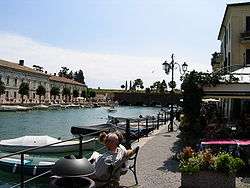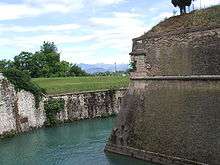Peschiera del Garda
| Peschiera del Garda | |
|---|---|
| Comune | |
| Comune di Peschiera del Garda | |
 | |
 Peschiera del Garda Location of Peschiera del Garda in Italy | |
| Coordinates: 45°26′N 10°41′E / 45.433°N 10.683°ECoordinates: 45°26′N 10°41′E / 45.433°N 10.683°E | |
| Country | Italy |
| Region | Veneto |
| Province / Metropolitan city | Verona (VR) |
| Frazioni | Peschiera, San Benedetto di Lugana, Broglie |
| Government | |
| • Mayor | Umberto Chincarini |
| Area | |
| • Total | 17.63 km2 (6.81 sq mi) |
| Elevation | 68 m (223 ft) |
| Population (2011)[1] | |
| • Total | 9,995 |
| • Density | 570/km2 (1,500/sq mi) |
| Demonym(s) | Arilicensi |
| Time zone | CET (UTC+1) |
| • Summer (DST) | CEST (UTC+2) |
| Postal code | 37019, 37010 |
| Dialing code | 045 |
| Patron saint | Saint Martin |
| Saint day | November 11 |
| Website | Official website |
Peschiera del Garda [peˈskjeːra dɛl ˈɡarda] (Venetian: Pischera; Latin: Ardelica, Arilica) is a town and comune in the province of Verona, in Veneto, Italy. When Lombardy-Venetia was under Austrian rule, Peschiera was the northwest anchor of the four fortified towns constituting the Quadrilatero. The fortress is on an island in the river Mincio at its outlet from Lake Garda.
%2C_crop_moraine_hills_Villages_Lake_Garda_probably_Peschiera_del_Garda.jpg)
History
Roman Ardelica was a town of Gallia Transpadana that occupied the site of the modern Peschiera del Garda, at the southeast angle of the Lacus Benacus (Lago di Garda), just where the Mincius (modern Mincio) issued from the lake. The name is found under the corrupted form Ariolica in the Tabula Peutingeriana, which correctly places it between Brixia and Verona; the true form is preserved by inscriptions, of which one says that it was a trading place, with a corporation of ship-owners, collegium naviculariorum Ardelicensium. (Orell. Inscr. 4108.) The town is mentioned as Arilica in Pliny the Elder's Naturalis Historia.
The fortress at Peschiera played a prominent part in most military campaigns conducted in northern Italy after 1400, especially campaigns conducted during the Napoleonic wars. During the First Italian War of Independence, it was taken by the Piedmontese from the Austrians, after a gallant defence by General Rath lasting six weeks, on May 30, 1848.
Peschiera del Garda was also known for its military jail, which closed in 2002.
The comune is part of the Associazione Città del vino ("Association of Wine Cities").
In winter, the nearby Laghetto del Frassino is the most important habitat for tufted ducks in Italy (Morbioli & Sighele 2006).
Main sights

- The Fortress and the external fortifications
- Sanctuary of Madonna del Frassino (1511). It houses works by Paolo Farinati and Zeno da Verona
Bounding communes
Transport
Peschiera del Garda railway station, opened in 1854, forms part of the Milan–Venice railway.
Twin cities
World heritage site
It is home to one or more prehistoric pile-dwelling (or stilt house) settlements that are part of the Prehistoric Pile dwellings around the Alps UNESCO World Heritage Site.[2]
References
- Morbioli, Marco; Sighele, Maurizio (2006). "L'avifauna del Laghetto del Frassino (Peschiera del Garda, Verona, Veneto)". Bollettino del Museo Civico di Storia Naturale di Verona Botanica Zoologia (30): 275–291. PDF fulltext
